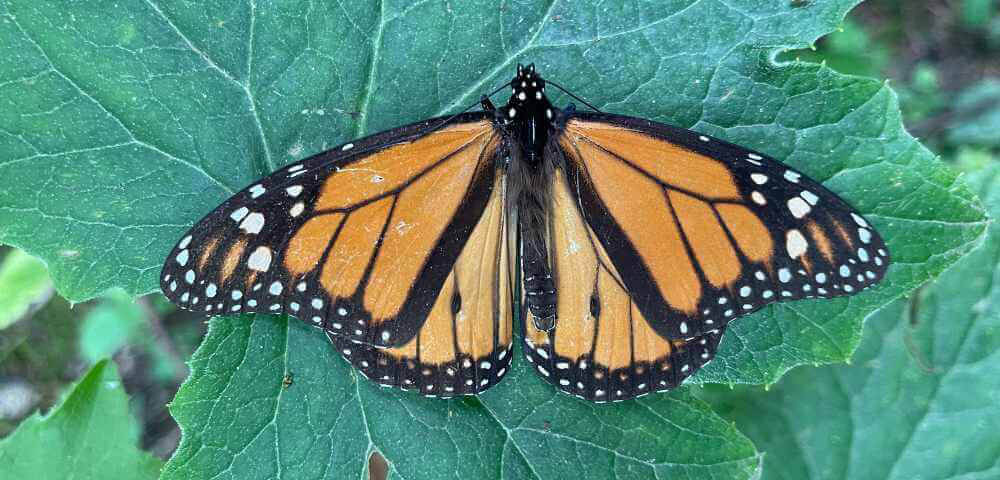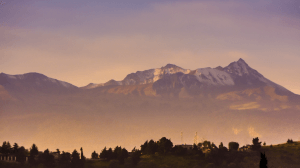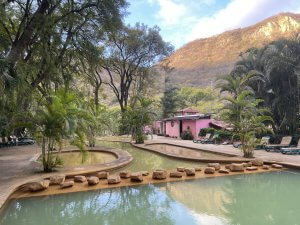Tales of Two Migrations: Gray Whales and Monarch Butterflies
Nature has orchestrated two extraordinary migrations along North America’s coasts and interior – the Pacific gray whale and the Monarch butterfly. While vastly different in size and species, these incredible journeys share fascinating parallels that tell us something profound about the persistence of life.
The Gray Whale’s Journey
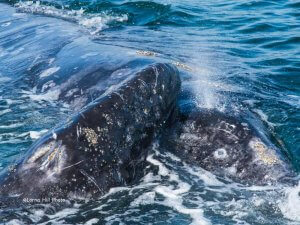 Every year, gray whales undertake a 12,000-mile round trip from their summer feeding grounds in the Bering Sea to the warm, protected lagoons of Baja California. Usually they begin their southward journey in October, traveling as a single generation, with pregnant mothers leading the migration. In the warm Mexican waters, they give birth and nurture their calves before beginning their northward return in late winter.
Every year, gray whales undertake a 12,000-mile round trip from their summer feeding grounds in the Bering Sea to the warm, protected lagoons of Baja California. Usually they begin their southward journey in October, traveling as a single generation, with pregnant mothers leading the migration. In the warm Mexican waters, they give birth and nurture their calves before beginning their northward return in late winter.
The Monarch’s Multi-Generational Trek
In contrast, the monarch’s annual 3,000-mile journey from Canada to central Mexico is a relay race across generations. No single butterfly completes the entire round trip. Instead, it takes 4-5 generations to complete the annual cycle. The final generation, born in late summer, makes the remarkable southern migration to Mexico’s oyamel fir forests, where they cluster by the millions during winter.
Having worked for years in San Ignacio Lagoon alongside the incredible Eastern Pacific Gray Whales, I never thought I’d find myself exploring the Monarch Butterfly sanctuaries in Central Mexico as a potential tour to guide. However, when my colleague at Baja Ecotours, Risa, set up this expedition and asked me to join, I was incredibly excited to embark on this bucket list adventure!
The inspiration for this trip sparked a few years ago after an interesting client, Conservation Biologist Dr. Alfonso Alonso, came to stay at Campo Cortez to see the majestic gray whales. He planted an idea in our heads that we just couldn’t shake.
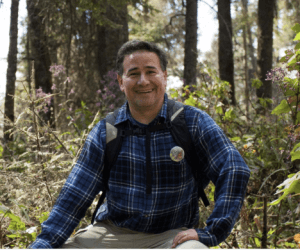 Having studied the ecology and conservation of monarch butterflies for his master’s and doctoral degrees, Dr. Alonso possessed a deep understanding of these remarkable creatures. As he shared his insights, I was awestruck by the trials and tribulations these tiny insects face on their extraordinary migration. His words resonated deeply, reminding me of the challenges faced by the gray whales and highlighting the shared struggles of these magnificent creatures, albeit on vastly different scales.
Having studied the ecology and conservation of monarch butterflies for his master’s and doctoral degrees, Dr. Alonso possessed a deep understanding of these remarkable creatures. As he shared his insights, I was awestruck by the trials and tribulations these tiny insects face on their extraordinary migration. His words resonated deeply, reminding me of the challenges faced by the gray whales and highlighting the shared struggles of these magnificent creatures, albeit on vastly different scales.
I learned that Dr. Alonso also leads trips to the overwintering forests of the eastern Pacific butterfly, further piquing my interest. Given his expertise and the fact that Mexico is his country of origin, I felt incredibly interested in sharing his knowledge with my co-workers and the rest of the guests at the camp. I also felt a little bold with my idea, but Dr. Alonso’s genuine passion for the monarchs and his kind and approachable nature made it easier to approach him with the idea.
He graciously obliged, and his passionate presentation ignited a spark within us, inspiring us to explore the possibility of offering our own Monarch butterfly tour. We envisioned a unique itinerary that would seamlessly complement our existing gray whale watching tours, leveraging the similar migration timing of these two magnificent creatures.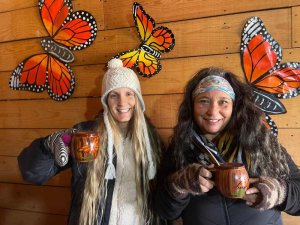
From this enlightenment, I set off with Risa, and her friend April, to the Monarch Butterfly Reserve in Michoacan. Risa and April both live in San Diego and have watched the Monarch butterflies pass overhead (and even land in their butterfly-friendly gardens!) whilst traveling on their migration route. So I couldn’t have been in better company whilst not only scouting for the trip but for the search for the Monarch Butterfly.
A Prelude to Adventure: Arriving in Mexico City
Mexico City, a vibrant tapestry of ancient and modern, pulsed with an energy that mirrored the beating wings of the Monarch butterflies we sought. The city, perched at a dizzying altitude, offered a glimpse into the soul of Mexico – a land where indigenous traditions, like the reverence for these winged wonders, have endured for centuries.
As we walked through the bustling streets towards the Zócalo, the historic heart of the city, I felt a sense of anticipation growing within me. Thoughts of the pre-Hispanic cultures, so deeply ingrained in the fabric of Mexico City, filled my mind.
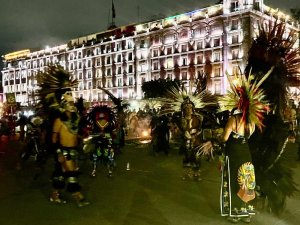

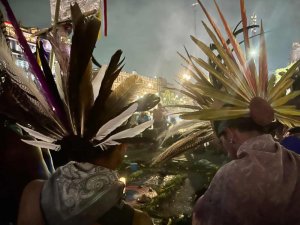
This unexpected encounter sparked my curiosity about the Purepecha people, the indigenous inhabitants of central Mexico with whom the Aztecs had a long and complex history. These were the people, I learned, who held a deep spiritual connection to the Monarch butterflies, a connection that added another layer of intrigue to my journey. I felt a growing excitement, eager to delve deeper into this ancient reverence and witness the magic of the Monarch migration firsthand.
Chapultepec Charm
Before embarking on our journey to witness the awe-inspiring Monarch Butterfly migration in Michoacán, we decided to immerse ourselves in the vibrant culture of Mexico City. We chose to stay in the charming Chapultepec neighborhood, and it proved to be the perfect starting point for our cultural exploration.
Chapultepec Park, one o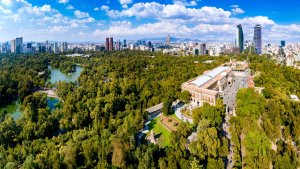 f the largest urban parks in the world, dominates the area. Its sprawling 1,695 acres offer a welcome escape from the city bustle, with lush gardens, serene lakes, and captivating museums. The iconic Chapultepec Castle, perched atop the hill, is a must-visit. This historic landmark, once a royal residence, now houses the National Museum of History, showcasing Mexico’s rich past through fascinating exhibits.
f the largest urban parks in the world, dominates the area. Its sprawling 1,695 acres offer a welcome escape from the city bustle, with lush gardens, serene lakes, and captivating museums. The iconic Chapultepec Castle, perched atop the hill, is a must-visit. This historic landmark, once a royal residence, now houses the National Museum of History, showcasing Mexico’s rich past through fascinating exhibits.
Staying in Chapultepec allowed us to easily explore the surrounding cultural treasures. We strolled through the vibrant Paseo de la Reforma, admired the impressive murals of Diego Rivera, and indulged in the delicious street food that Mexico City is famous for. The neighborhood’s blend of history, art, and vibrant life provided a captivating introduction to our Mexican adventure, leaving us eager to explore further.
The Monarch Butterfly Biosphere Reserve 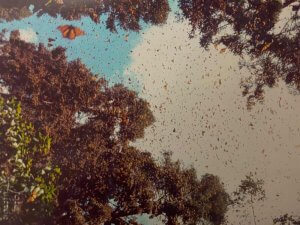
Designated a UNESCO World Heritage Site in 2008, this magnificent reserve encompasses over 56,000 hectares of forests (temperate pine, oyamel and oak) and meadows, providing a crucial winter habitat for millions of Monarch butterflies that migrate annually from eastern North America.
The reserve, established in 1980 through a collaborative effort between the Mexican government and local communities, has played a crucial role in preserving the oyamel fir forests – habitats for over 260 bird species and countless other animals, namely the Lynx, Aztec blackbird and brook salamander.
The Monarch butterfly sanctuaries attract a significant number of tourists (more than 150,000 visitors per year, according to UNESCO), generating income for local communities through ecotourism activities, such as guided tours, accommodation, and local crafts, fostering cultural exchange and environmental awareness among visitors.
The Road to Michoacán
The following morning, we embarked on our 3.5 hour journey towards the heart of the Monarch Butterfly Biosphere Reserve in the mountainous state of Michoacan, following the Trans-Mexican Volcanic Belt.
 We were traveling with Mexico City native, Felipe, our dedicated driver for the entire trip whom we’d hired to take us to the sanctuaries. Felipe’s intimate knowledge of the area and extensive experience driving long distances were vital for keeping us safe and well-informed, not only on our journey to the sanctuaries but also during our time there and for a comfortable return to Mexico City.
We were traveling with Mexico City native, Felipe, our dedicated driver for the entire trip whom we’d hired to take us to the sanctuaries. Felipe’s intimate knowledge of the area and extensive experience driving long distances were vital for keeping us safe and well-informed, not only on our journey to the sanctuaries but also during our time there and for a comfortable return to Mexico City.
As we drove out of Mexico City, we caught a glimpse of the impressive high-speed train cutting through the landscape, a testament to the city’s modern infrastructure. Looking up, we spotted the colorful cabins of the cable car system, offering a unique perspective of the bustling metropolis.
Further into our journey, the landscape began to change dramatically as we ascended into the foothills of the majestic Nevado de Toluca, a snow-capped volcano that dominates the horizon. The air grew cooler as we climbed higher and higher, winding our way through picturesque mountain villages and lush pine forests. We were traveling through Michoacán, a state renowned for its agricultural bounty.
Beyond the renowned avocados, Michoacán is a significant producer of corn, the state’s most harvested crop. Other agricultural products include avocados, strawberries, peaches, limes, sugar cane, and mangoes. The anticipation of witnessing the incredible spectacle of the Monarch butterfly migration grew with every mile we traveled, promising an unforgettable adventure.
About an hour from El Rosario, we stopped at a vibrant local fruit market in a town called Zitácuaro. We couldn’t resist the temptation of locally produced honey and the fragrant guayaba, a tropical fruit with a unique sweet and tangy flavor. Guayaba is not only delicious but also rich in vitamin C and antioxidants.
El Rosario
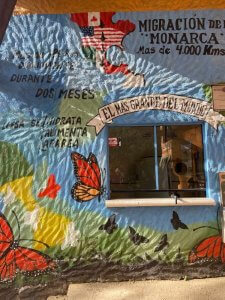 As we approached the El Rosario sanctuary, a wave of excitement washed over us. Stepping out of the car at the concession stand area, we were immediately captivated by the sights and smells. The aroma of delicious, freshly cooked food tantalized our senses, while vibrant displays of handmade artisan crafts and products beckoned us to explore. It was clear that this was more than just a sanctuary; it was a vibrant hub of local culture and community.
As we approached the El Rosario sanctuary, a wave of excitement washed over us. Stepping out of the car at the concession stand area, we were immediately captivated by the sights and smells. The aroma of delicious, freshly cooked food tantalized our senses, while vibrant displays of handmade artisan crafts and products beckoned us to explore. It was clear that this was more than just a sanctuary; it was a vibrant hub of local culture and community.
Alfonso, our knowledgeable friend, had warned us that time was of the essence. To maximize our chances of witnessing the butterflies in their full glory, we needed to reach the sanctuary before the sun began to set. With this in mind, we eagerly embraced Alfonso’s suggestion of a horseback ride to the higher elevations. While walking was an option, we knew that horseback riding would not only conserve our energy for the rest of our journey but also contribute to the local economy by supporting the livelihoods of the horsemen.
witnessing the butterflies in their full glory, we needed to reach the sanctuary before the sun began to set. With this in mind, we eagerly embraced Alfonso’s suggestion of a horseback ride to the higher elevations. While walking was an option, we knew that horseback riding would not only conserve our energy for the rest of our journey but also contribute to the local economy by supporting the livelihoods of the horsemen.
As we began our ascent, we were assigned a knowledgeable guide. He not only navigated us through the winding trails within the sanctuary but also provided invaluable insights into the delicate ecosystem and the unique behavior of the Monarch butterflies. He emphasized the importance of maintaining a respectful distance, minimizing noise, and staying on designated trails to protect the butterflies and their fragile habitat. This guidance enhanced our experience, allowing us to appreciate the beauty and fragility of this natural wonder while minimizing our impact.
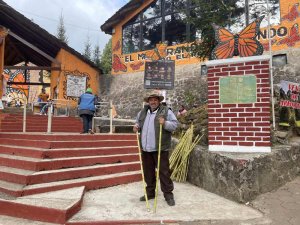
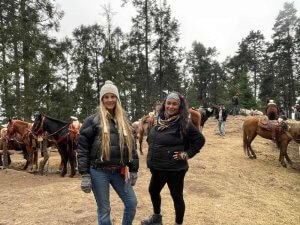

The Butterflies
As we ascended higher, the air grew thinner and cooler, and our voices gradually softened in respect for the tranquility of the surrounding environment. The anticipation built with every step, every hoofbeat echoing through the stillness of the forest. Finally, we reached the heart of the sanctuary. 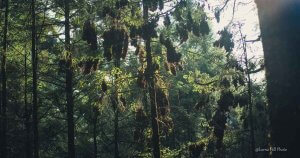
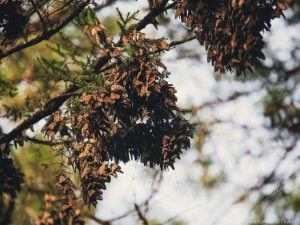
And then, we saw them. Millions upon millions of Monarch butterflies, clinging to the branches of the oyamel fir trees. The sight was simply breathtaking. The trees, heavy with the weight of the butterflies, bowed gracefully under their burden. A gentle breeze rustled through the branches, causing a mesmerizing movement among the butterflies, their wings fluttering like a kaleidoscope of orange and black. The collective sound of their wings beating was a soft, ethereal hum, a symphony of nature.
Our guide, a wealth of knowledge about these incredible creatures, explained the intricacies of their remarkable journey. He told us that the Monarch butterflies undertake a truly astonishing multi-generational migration, covering thousands of miles each year, and that these Monarchs, the Eastern population, arrive in Mexico around November and settle in these specific mountainous regions of Michoacán. 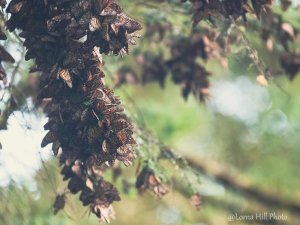
From the months of November to January, they are “overwintering”, clustering together on tree branches for warmth and enter a semi-dormant state, conserving energy. They primarily live off fat reserves built up during the migration and become active on warm days to drink nectar or water.
Come February – March, these overwintering butterflies become sexually mature, and mating occurs in these forests before the northward migration.
By March – April, Spring migration begins from Mexico and the Monarchs start northward migration, leaving the oyamel fir forests.
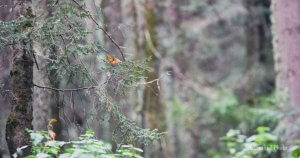 The monarch’s life is a remarkable journey of transformation. It begins as a tiny egg, laid on milkweed plants—the sole food source for the developing caterpillar that will hatch out of the egg. These first-generation eggs typically hatch in 3-10 days in regions like Texas, northern Mexico, Louisiana, and other Gulf Coast states.
The monarch’s life is a remarkable journey of transformation. It begins as a tiny egg, laid on milkweed plants—the sole food source for the developing caterpillar that will hatch out of the egg. These first-generation eggs typically hatch in 3-10 days in regions like Texas, northern Mexico, Louisiana, and other Gulf Coast states.
Then throughout the summer, mating continues to occur and the second, third, and fourth generations are produced, each generation surviving for about 2-6 weeks, before coming to the fourth generation.
Now, this generation, the remarkable migratory generation, enters what’s called a reproductive diapause (delayed sexual maturity) and survives for about 8-9 months to complete the southern journey ending up in these Mexican forests, only to start the cycle again.
Timing and Territory
Both species, Gray whale and Monarch Butterfly have evolved to synchronize their migrations with seasonal changes:
– Gray whales time their arrival in Baja to coincide with optimal birthing conditions
– Monarchs migrate south to warmer climates in the Mexican mountains to overwinter, essentially “hibernating” until spring when they can return to lay eggs in the north again. Also, their arrival in Mexico coincides as Day of the Dead celebrations begin, leading to rich cultural connections with local communities
in the north again. Also, their arrival in Mexico coincides as Day of the Dead celebrations begin, leading to rich cultural connections with local communities
The Navigation
Now, you’re probably wondering how both species find their way?
Gray whales undertake one of the longest migrations of any mammal, traveling approximately 10,000 to 12,000 miles annually from their feeding grounds in the Arctic to the warm lagoons of Baja California for breeding and calving. This remarkable journey begins in the Bering and Chukchi Seas around October, as the northern ice pushes southward, signaling the whales to migrate southward.
Gray whales utilize several methods to navigate their extensive migration route. Primarily, they rely on acoustic communication, producing a variety of vocalizations that can travel long distances underwater, which helps them orient themselves and maintain contact with other whales during their journey.
Additionally, they are believed to use environmental cues such as water temperature, currents, and coastal landmarks to guide their path, often following the coastline for a more direct route while avoiding open ocean hazards. Furthermore, adult gray whales likely draw on their memory and experience from previous migrations, enabling them to navigate effectively to their traditional calving lagoons in Baja California, where they seek the warmer waters necessary for giving birth and nursing their calves.
 The Monarch butterfly’s navigational abilities are nothing short of astonishing. One significant study highlighted that Monarchs can use a time-compensated sun compass during both their southward migration and the subsequent northward return. This mechanism allows them to adjust their flight direction based on the sun’s position throughout the day, which is crucial for long-distance travel.
The Monarch butterfly’s navigational abilities are nothing short of astonishing. One significant study highlighted that Monarchs can use a time-compensated sun compass during both their southward migration and the subsequent northward return. This mechanism allows them to adjust their flight direction based on the sun’s position throughout the day, which is crucial for long-distance travel.
Moreover, research has shown that Monarchs may possess the ability to detect polarized light patterns in the sky, which can provide additional orientation information when sunlight is obscured. This capability is particularly important for navigation under less-than-ideal visibility conditions.
Recent research even suggests that Monarchs may possess a magnetic sense, allowing them to detect the Earth’s magnetic field and further refine their navigational course.
While direct evidence of star navigation in Monarchs is still being explored, their reliance on celestial cues like the sun and potentially stars underscores the complexity of their migratory behavior.
The navigation skills of Monarch butterflies are not just a testament to their resilience but also a stunning example of evolution’s wonders. Their adaptations highlight the incredible strategies found in nature, reminding us of the complex interplay between organisms and their environments.
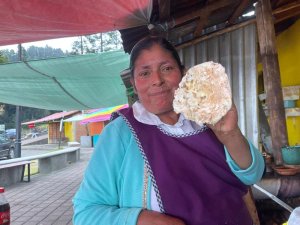
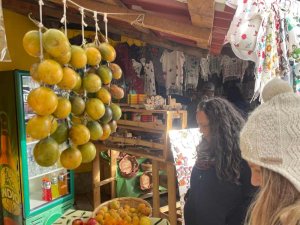
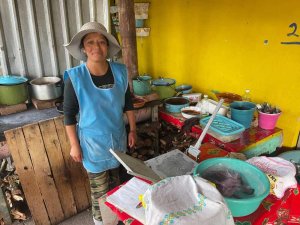
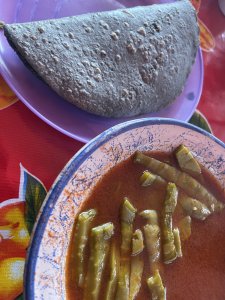 After an afternoon spent marveling at the millions of fluttering wings, we decided to indulge in the local cuisine. The enticing aroma of freshly-made tortillas led us to a small, family-run eatery. We watched in fascination as a woman deftly shaped tortillas from vibrant blue corn, a local specialty. We couldn’t resist the temptation of quesadillas filled with delicate squash blossoms (flor de calabaza)and a steaming bowl of mushroom soup, a truly unforgettable culinary experience.
After an afternoon spent marveling at the millions of fluttering wings, we decided to indulge in the local cuisine. The enticing aroma of freshly-made tortillas led us to a small, family-run eatery. We watched in fascination as a woman deftly shaped tortillas from vibrant blue corn, a local specialty. We couldn’t resist the temptation of quesadillas filled with delicate squash blossoms (flor de calabaza)and a steaming bowl of mushroom soup, a truly unforgettable culinary experience.
Sated and content, we wandered through the stalls of the local artisans. Vibrant textiles woven with intricate patterns, delicate wood carvings depicting the Monarch butterfly, and handcrafted jewelry adorned with colorful beads caught our eye. We chatted with the artisans, learning about their techniques and the inspiration behind their creations. Each purchase felt more than just a souvenir; it was a tangible connection to the local community and a support for their livelihoods. As we drove away from El Rosario, we carried with us not only the memory of the breathtaking butterfly spectacle but also the warmth of the local hospitality and the unique treasures we had discovered among the artisans.
A dip into thermal springs
From EL Rosario, we traveled to the enchanting Agua Blanca Hotel. Nestled amidst lush greenery, this historic property boasts a rich history dating back to the 18th century. Built around a series of natural thermal springs, Agua Blanca has long been a haven for relaxation and rejuvenation. The hotel’s founders, recognizing the healing properties of the mineral-rich waters, established the resort as a sanctuary for wellness and tranquility. Today, guests can still experience the rejuvenating effects of these thermal waters, which are believed to possess therapeutic properties for various ailments. 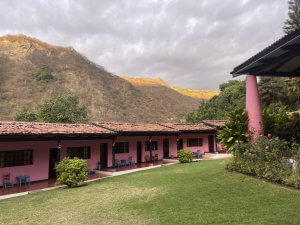
The surrounding natural beauty was equally captivating. We spent many hours relaxing by the waterfall, watching vibrant hummingbirds flitting among the flowers while 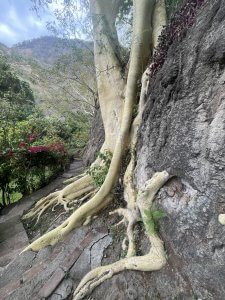 listening to the melodious calls of the elusive Slaty-tailed Trogon, the stunning Emerald-Throated Toucanet, and the brightly colored Lesson’s Motmot, all of which can be found (and heard!) within the hotel grounds.
listening to the melodious calls of the elusive Slaty-tailed Trogon, the stunning Emerald-Throated Toucanet, and the brightly colored Lesson’s Motmot, all of which can be found (and heard!) within the hotel grounds.
The grounds are also home to a variety of other fascinating creatures native to the region, including the tlacuache (opossum), armadillo, calandria (blackbird), and the elusive cacomixtle (a raccoon-like mammal). The hotel grounds are adorned with incredible trees, including the majestic Tziranda, a magnificent yellow tree with long, flowing roots that gracefully cascade down the cliffs like arms reaching for the earth. The hotel grounds also provided a glimpse into the local flora, with fruit trees laden with ripe avocados, guayabas, and mangoes, many of which were used to create the delicious jams served at breakfast.
Sierra de Chincua
The next morning, we embarked on our visit to the Sierra Chincua sanctuary. While both El Rosario and Sierra Chincua are renowned for their overwintering Monarch butterfly populations, Sierra Chincua offers a different perspective. The terrain here is more rugged, with the butterflies often clustering higher up on the mountain slopes. As we ascended, we were captivated by the lushness of the forest – moss-covered rocks, towering oyamel firs, and vibrant wildflowers adding splashes of color to the undergrowth. We once again opted for horseback riding, further immersing ourselves in the local community as we enjoyed the camaraderie with the horsemen and their sure-footed companions.
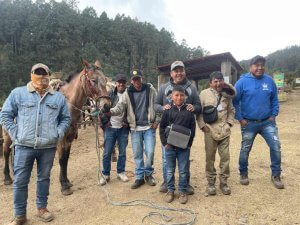


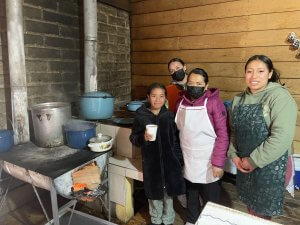
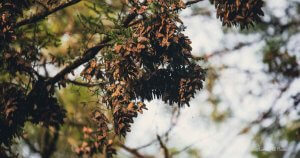 Our trip to Michoacán was more than just a journey to witness a natural wonder; it was a deeply enriching and rejuvenating experience. Spending time immersed in nature, surrounded by the beauty of the oyamel forests, the vibrant energy of the Monarch butterflies, and the warm hospitality of the local communities was incredibly healing. As I reflected on the remarkable migration of these delicate creatures, my mind continually wandered to the majestic gray whales and the upcoming 10 years we’ll be working with them within the Vizcaino Biosphere Reserve of Baja California Sur. Both migrations, not so different to each other in scale and scope, are awe-inspiring testaments to the power of instinct, the strength of survival, and the interconnectedness of all living beings. Witnessing these incredible journeys ignited a renewed sense of wonder and a profound respect for the delicate balance of our natural world, stirring a hunger within me to continue advocating for the protection of all species and their habitats.
Our trip to Michoacán was more than just a journey to witness a natural wonder; it was a deeply enriching and rejuvenating experience. Spending time immersed in nature, surrounded by the beauty of the oyamel forests, the vibrant energy of the Monarch butterflies, and the warm hospitality of the local communities was incredibly healing. As I reflected on the remarkable migration of these delicate creatures, my mind continually wandered to the majestic gray whales and the upcoming 10 years we’ll be working with them within the Vizcaino Biosphere Reserve of Baja California Sur. Both migrations, not so different to each other in scale and scope, are awe-inspiring testaments to the power of instinct, the strength of survival, and the interconnectedness of all living beings. Witnessing these incredible journeys ignited a renewed sense of wonder and a profound respect for the delicate balance of our natural world, stirring a hunger within me to continue advocating for the protection of all species and their habitats.



